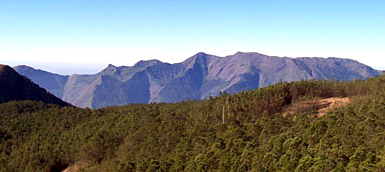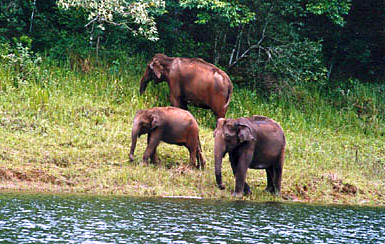 In Idukki District the green mountains, the chirp of wild birds, dark and deep forests and the rare flora and fauna welcomes visitors not only to have a look but also understand, feel and perhaps realise, the beauty, power and glory of life.
In Idukki District the green mountains, the chirp of wild birds, dark and deep forests and the rare flora and fauna welcomes visitors not only to have a look but also understand, feel and perhaps realise, the beauty, power and glory of life.
Santalum album or chandanam, Anogeissus latifolia or Mazhukanjiram, Tamarindus Indica or Puli, Terminalia arjuna or nirmaruthu, Pongamia glabra or pongau, Largerstoemia lanceolata or Ventheku, Dalbergia latifio or Rosewood, Tectona grandis or Teak, Cassia fistula or Konna, Terminalia bellerica or Thanni, Emblica officianalis or Nelli etc. are the common species.Rhododendrom Nilagiricum or Kattu chemparathi, Elaeocarpus recurvatus or Bhadraksam, and Strobillanthus kunthianus or Neelakurunji grow in these areas.
Elephant, Gaur, Panther, Spotted deer, Sambar, Giant Grizzled Squirrel, Hanuman monkey, Rabbit etc. inhabit the Chinna forests. Among them the Giant Grizzled Squirrel is an endangered species, which is dull gray in colour.
The Chinnar sanctuary is accessible by roads, which are good in quality from the Airports of Coimbatore and Kochi. The nearest railway stations are Aluva that is 200 km and Pollachi that is 60km in distance.
While traveling along the road from Karimutti to Chinnar, different animals like elephant, spotted deer, sambar, hanuman monkey and even peacocks on either side of the road can be seen. This is a unique experience regarding this sanctuary because in case of other sanctuaries one has to go deep into the jungle to see wildlife.
Periyar Tiger Reserve:
The Periyar Tiger Reserve is ideal for watching the Asian Elephant in close proximity. It has a varied topography and it is stretched across 777 sq. km, the central part constituting an area of 350 sq. km. and is one of the largest in India. Its main attraction is the beautiful Periyar Lake with its unparalleled scenic beauty and the facilities offered by the Periyar Lake formed by the damming of the Periyar River attracts a lot of tourists every year. The sanctuary spreads over an area of 673 sq. km and is situated at a height of 900 to 1800 metres above main sea level. Facilities are also available for cruising in this lake.
Idukki Wild Life Sanctuary:
 This sanctuary extends over the Thodupuzha and Udumpanchola taluks of Idukki district spreading over 105 Sq. Km. and situated at 450-748m above sea level. The Idukki reservoir formed by three dams namely Cheruthoni, Idukki and Kulamavu, which extend to 33 sq km.
This sanctuary extends over the Thodupuzha and Udumpanchola taluks of Idukki district spreading over 105 Sq. Km. and situated at 450-748m above sea level. The Idukki reservoir formed by three dams namely Cheruthoni, Idukki and Kulamavu, which extend to 33 sq km.
Animals that are found in this sanctuary are Elephants, Porcupine, Sambar Deer, Wild dogs, jungle cats, Malabar Gaint Squirrel, Wild boar etc. Among the snakes Cobra, Viper, Krait and a large number of non-poisonous snakes are available. Birds as the Jungle fowl, Myna, Laughing thrush, Black bulbul, Peafowl, Wood pecker, King fisher etc. are the name of the birds which takes an important part to enrich the treasure.
Chinnar Wildlife Sanctuary:
Chinnar was declared as a wildlife sanctuary in 1984. This place is lying in Devikulam Taluk of Idukki district and is located in the rain shadow region of Western Ghats. It is the second habitat for the endangered Giant Grizzled Squirell in India. This sanctuary has an area of 90.422 sq km, and has the unique thorny scrub forest with Xerophytic species.
The undulated landscape with rocky patches increases the scenic brilliance of the sanctuary. As the altitude varies from 500 to 2400 metres within a few kilometre radiuses, there is a drastic variation in the climate and vegetation. The highest peaks are Kottakombumalai that is 2144 metre height, Vellaikal malai i.e.1863m, and Viriyoottu malai whose height is 1845 metre. Unlike in most forests of Kerala, Chinnar gets only about 48 rainy days in a year during October - November i.e. North-East Monsoons. The forest types comprise thorny scrub forests, dry deciduous forests, high shallows and wet grasslands.



















